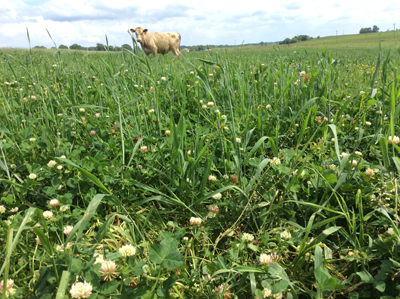Soil Science Society of America
5585 Guilford Road • Madison, WI 53711-5801 • 608-273-8080 • Fax 608-273-2021
www.soils.org
Twitter | Facebook
NEWS RELEASE
Contact: Hanna Jeske, Associate Director of Marketing and Brand Strategy, 608-268-3972, hjeske@sciencesocieties.org
What are the benefits of growing multiple types of forage grasses for grazing animals?
Jan. 2, 2018 – Grazing animals, such as cattle and sheep, should eat their legumes and brassicas. The Soil Science Society of America (SSSA) January 1 Soils Matter blog post explains how a variety of forage grasses benefits these animals as well as the soil and environment.
 “Most of their grazing time, grazing animals are making decisions about what to eat with every bite,” says Jesse Morrison, a researcher at the Department of Plant and Soil Sciences, Mississippi State University. “Luckily for the animals, they don’t normally have only one option for their meal in a pasture setting. Growing multiple plant species in the same space at the same time, polyculture, is the norm in pasture grazing scenarios.”
“Most of their grazing time, grazing animals are making decisions about what to eat with every bite,” says Jesse Morrison, a researcher at the Department of Plant and Soil Sciences, Mississippi State University. “Luckily for the animals, they don’t normally have only one option for their meal in a pasture setting. Growing multiple plant species in the same space at the same time, polyculture, is the norm in pasture grazing scenarios.”
Polyculture brings more nutrition to the grazing animals: Legumes like clover and alfalfa provide protein. Brassicas like turnips and kale round out their diet.
But the benefits also extend to the soil. Those legumes bring valued nitrogen to the soil, and brassicas reduce soil compaction with their strong roots. In addition, a diversity of plants brings a diversity of soil organisms, insects, songbirds, and other wildlife.
“The biodiversity of the entire grazing system is increased with polyculture, which is good for the environment. What more could you ask for?” Morrison asks.
To read the entire blog post, visit https://soilsmatter.wordpress.com/2018/01/01/what-are-the-ben…-grazing-animals/. (NOTE REGARDING EMBARGO: The blog will not be live until January 1. Please contact us directly if you need more details.)
Follow SSSA on Facebook at https://www.facebook.com/SSSA.soils, Twitter at SSSA_Soils. SSSA has soils information on www.soils.org/discover-soils, for teachers at www.soils4teachers.org, and for students through 12th grade, www.soils4kids.org.